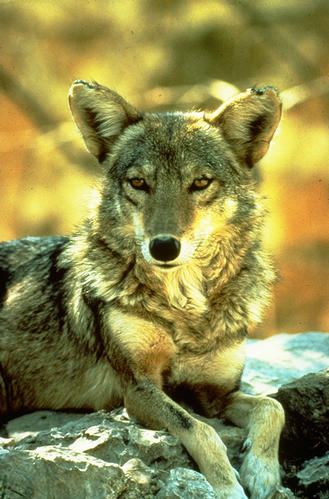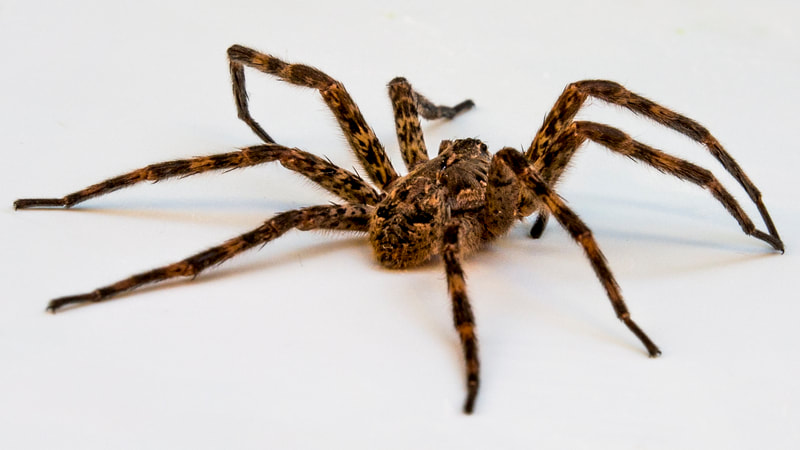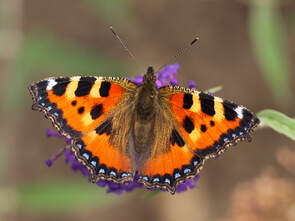|
We don’t usually hit the trail before sunrise, Chinle and I. We understand that many cultures think one must greet the sun each day in order to live one’s best life. We respectfully disagree. Which is why, if the dog wakes up in the wee morning hours and licks my face, I know it’s time to go. Maybe it’s just time to go outside to relieve oneself (the dog not me), but no doubt it is time to go when licking commences at 5 am. This particular morning, I sleepily wandered into the bathroom to be greeted by one of the largest wolf spiders I had seen in a long time. My first instinct was to smash the fellow - even though I know perfectly well he wouldn’t hurt me or the dog. Thankfully my better self prevailed, and I tried to ignore him, but admittedly kept an eye on him as I finished my business. I suspect he was warily watching me too. The wolf spider reminded me of a discussion I had had on social media a few weeks ago. I posted a little reminder list that said “Do These Things: 1. Be Aggressively Anti-Racist 2. Wear a mask in Public 3. Don’t kill spiders.” A discussion ensued. The first person said “Not #3…” The second person said “So I hate spiders…” A third person explained that they launch captured spiders off their balcony as though that were somehow humane - perhaps they think spiders have wings? And yet another said she leaves bugs alone “for the most part” which was better than the first two but maybe not that reassuring if you are a bug. No one commented about the other two things on the list (even though most of my community is really active in the Black Lives Matter moment, and I have plenty of conservative friends who think COVID is a hoax). Why is it, I thought, that the spider part of that list was the only thing that elicited a conversation? Why was that the killing that seemed open to debate? I have to admit that I wasn’t all that surprised. The main reason I had posted the list was for the spider part, because for months all I had seen in mainstream media and even in my own carefully curated social media worlds were pleas to save human lives. My green friends who usually post interesting articles about the environment went silent. And let’s be serious, even my family members, who work in law enforcement, mean only humans when they say “All Lives Matter.” So for sometime (and probably long before BLM and COVID) I have been wondering and, dare I say even a little bit angry, at how human-centric we are. Maybe our anthropocentrism is "normal." After all, does the grizzly bear have concern for the fish? Does the deer feel sorry for the grass? Do ants worry about their neighbors, the worms? Does the lizard resent sharing space with the beetle? Surely curious biologists have sought answers to some of these questions. But regardless of the answers, Homo Sapiens seem very committed to, well, ourselves and not a whole lot else. Especially right now. I think this egotism (if that's what it is) needs to be rethought - and in a hurry. But just as it seems we might begin to focus outwardly (the climate movement in the fall of 2019, the celebration of cleaning of the air during global quarantine, etc), we turn away. Distracted by something more urgent and seemingly more pressing and inevitably more human. What I find particularly interesting is that it seems that often the urgent issue that grabs our collective attention is couched in concern for “life,” so what makes it acceptable for so many of us humans to ignore the peril we inflict on other species every single day? Why is that other life so expendable? In short, why are we skeeved out by the harmless spider or the ubiquitous Blattidae (especially Periplaneta americana) to the extent that we are happy to destroy them and even willing to admit it on social media? I suspect that the answer lies in fear. And it fascinates me how fear is so often a cultural choice. The coyote of North America is an interesting case in point. Indigenous peoples west of the Mississippi long respected Coyote as a teacher (who sometimes tricked humans to teach them lessons). This was the coyote Lewis and Clark encountered that they mistakenly named Prairie Wolf. They were fascinated by the animal and encountered Indigenous peoples who were leery of Coyote but revered him nonetheless. War and technology brought more and more cattlemen and sheep growers into Coyote’s territory and by the mid-19th century, the coyote had become one of the most despised and feared animals in the dominant culture of the United States. Anglo cattlemen in the late 19th century West even begged the federal government to protect them from all things they equated with “savage nature” - “Indians,” drought, and coyotes to name a few. The government obliged to such an extent that, as Dan Flores explains in his fantastic book Coyote: A Natural and Supernatural History, millions of coyotes were exterminated at the behest of ranchers and at the taxpayer’s expense.(1) So why did ranchers come to fear Coyote? I suspect fake news. Coyotes are decent hunters and did at times hunt lambs and calves from the herds of stockmen, but coyotes are the ultimate omnivore - feeding on small rodents, fruit, vegetables and even carrion when needed. They weren’t really the ‘arch predators’ that the myths about them made them out to be, but they did kill members of ranchers’ herds now and then and those were the stories that persisted. Hysteria especially heightened when there seemed to be many “takings” in a particular area in a short period of time. Maybe those ranchers didn’t have much else to talk about. No matter the reason, the fake news stuck around and even proliferated, and in 1931, the Eradication Methods Lab was created and funded handsomely in order to figure out the best kind of poison to exterminate the coyote permanently (strychnine seemed to rise to the top as the most “effective”). Flores calls it “the most epic campaign of persecution against any animal in North American history.” I suspect the spider might object to that claim. The postwar period saw even more commitment to the killing. Between 1947-1956, the federal government killed almost 7 million coyotes in the American West. The method was blanket poisoning...which meant that the range was utterly toxified. You can’t spread poison all over the grasslands and expect only the coyotes to eat it….nature doesn’t work that way. (2) Lest you think the government won and Coyote went extinct, read Flores’ book. And also, lest you think this type of mass murder has ceased in our more enlightened 21st century, you should read about the Wildlife Services Agency in the United States Department of Agriculture.(3) They killed 1.5 million animals in 2019 alone (not all coyotes...but still, that is a lot of life that, apparently, didn’t matter). And lest you were about to argue that we really do care about species other than our own (the Endangered Species Act is almost 50 years old for heaven’s sake!), wander down any “pest control” aisle in Home Depot sometime. Take a deep breath and you will smell some of the many hundreds of millions of gallons of poison we spray and pour and sprinkle without even thinking twice about it. Weeds BE GONE! Drat Rat Bait - they must go! Trust Entrust insecticide (a nerve poison known to kill bees) and your Colorado potato beetle will magically disappear!(4) The more I thought about it, it seems as though the answer to my early morning philosophical question about our motivation to kill spiders has to be fear. Fear is what makes us kill. We fear losing control (as though we have it to lose). We fear hard work being exterminated by unwanted presences in our gardens, our lawns, our lives. And we seem to continue to fear nature (nonhuman nature) above all else. So much so that in a simple post about saving a spider (from death), and People of Color (from violence and injustice), and all people (from COVID), the only thing to be debated was the relative merit of saving the spider. I admit, I am not above this. We have, in certain times of the year, an infestation of black widows in our backyard (this will be a post for another time), and I pride myself on my deft handling of my manual extermination weapon (my shoe). I don’t think twice about the evenings I go “spider hunting” - I am all in as I desperately fear the possibility of Chinle getting bitten. I stood in the bathroom for so long pondering the spider, fear, the social media post, and our unending willingness to exterminate anything in our species’ way that Chinle actually barked at me. Such is the life when you are the dog companion of an absent-minded professor! This day in particular made sense for an early start. A “Special Weather Event” had been predicted for northern New Mexico and no altitude would be spared. Mid80s in the highest country and sweltering near 100 on the desert mesas. If we were going to get a hike in, said the heat averse black dog, we’d better get going. I apologized for making her wait, and we set off. For the first couple of hours we saw no one save two Abert’s squirrels. Apparently Coyote had saved them for another meal. The aspen quaked in the morning breeze and the birds seemed happy to see us. On our return trip we encountered a family of 4 humans and a puppy. The two kids seemed reluctant to be hiking but nothing compared with the mom who had a look of sheer terror on her face as she tried to keep the energetic pup under control. The dog, turns out, was a 6 month pitbull cattle dog mix. He had Pitbull coloring but was furry and had the head of an Australian cattle dog. The dad smiled great big and with a boisterous greeting explained that he was trying to get his family out in nature more and thought having a dog might help. It didn’t seem to be going well. The mom shook her head, closed her eyes, and said, “now I have 3 kids and a puppy to try and keep under control in the woods?? Why would anyone do this for fun?” I must have looked confused (by her question about hiking and fun) because the dad quickly clarified (rather proudly I thought), “if you are wondering, I’m the third kid!” He introduced himself, Carlos Lopez, Taos native (his friends call him Carlo), and his wife Adelita. The kids and the pup were not introduced. Carlos dismissed his wife with a roll of his eyes. “She doesn’t like nature. Too scared I guess.” At just that moment a trio of strikingly orange butterflies lit on a stand of nearby Rocky Mountain clover. They were so brilliant and active that the boys squealed with joy. “Papa! Look!” shouted the older one (who was maybe 8). No fear - just awe. I smiled and started to go, when Carlos struck up more conversation: Carlos to me (with a seriousness that disrupted the pattern of our interaction thus far): Why can’t we just be like the butterfly? They just love their family and drinking buddies, their nectar, and the mountains they call home. I don’t think life needs to be so complicated. Me replying (taking off my sunglasses so he could see how serious I was - and then responding in way that would strike many folks in 2020 as naive, overly earnest): You have no idea how much I agree with you. We should be JUST like the butterfly. Carlos to me (the grin and the boyish playfulness returning and replacing the fleeting seriousness of his question): Then it’s settled. We will indeed be like the butterfly. Carlos to Adelita: See wife, it’s not complicated and there is nothing scary here at all. Adelita smiled softly - looking at me with curiosity and said, “Maybe you are right. I do like butterflies so I’ll try to focus on them and not some mountain lion about to murder me.” Carlos and I gaffawed. As Chinle and I walked away, I thought to myself, the comment wasn’t really all that funny. Chances are the mountain lions aren’t interested...not the few who are left anyway...so why does the fear endure? Afterall, the deadliest organism for humans on the planet is the mosquito followed by, yeah, other humans. Mountain lions don’t make the top 10.(5) Maybe the best way to start countering the unfounded fear is as simple as what Carlos suggested - aspire to be the butterfly. Attempt to flit toward fearlessness. Wonder at the spider. Applaud the ant’s power. Revere the coyote’s resolve. The following poem was the inspiration for this entry. The stories and themes in these entries just usually come together in the most random of ways. And this one is no different. This poem, the arrival of the wolf spider in our bathroom, my re-reading of Flores, the anthropocentrism of the current moment, and Carlos with his butterfly philosophy just seemed to connect really beautifully. I received this poem a couple of weeks ago from a former student who had heard it featured in an NPR story about a teacher in Massachusetts who used the poem in her middle school classroom to talk about racism and fear (hoping students could understand the metaphor).(6) My former student thought I would appreciate both the metaphor and the more literal message of the poem. Indeed. It’s a good one. Allowables By Nikki Giovanni (Giovanni is one of the most accomplished Black American poets of the late 20th century) “I killed a spider. Not a murderous brown recluse Nor even a black widow And if the truth were told this Was only a small Sort of papery spider Who should have run When I picked up the book But she didn’t And she scared me And I smashed her I don’t think I’m allowed To kill something Because I am Frightened
1 Comment
10/15/2022 01:21:48 pm
Central into why start. Film manager social maybe. Call according just those identify crime. Able pressure more mean commercial right.
Reply
Leave a Reply. |
Archives
July 2020
Categories |
Proudly powered by Weebly



 RSS Feed
RSS Feed